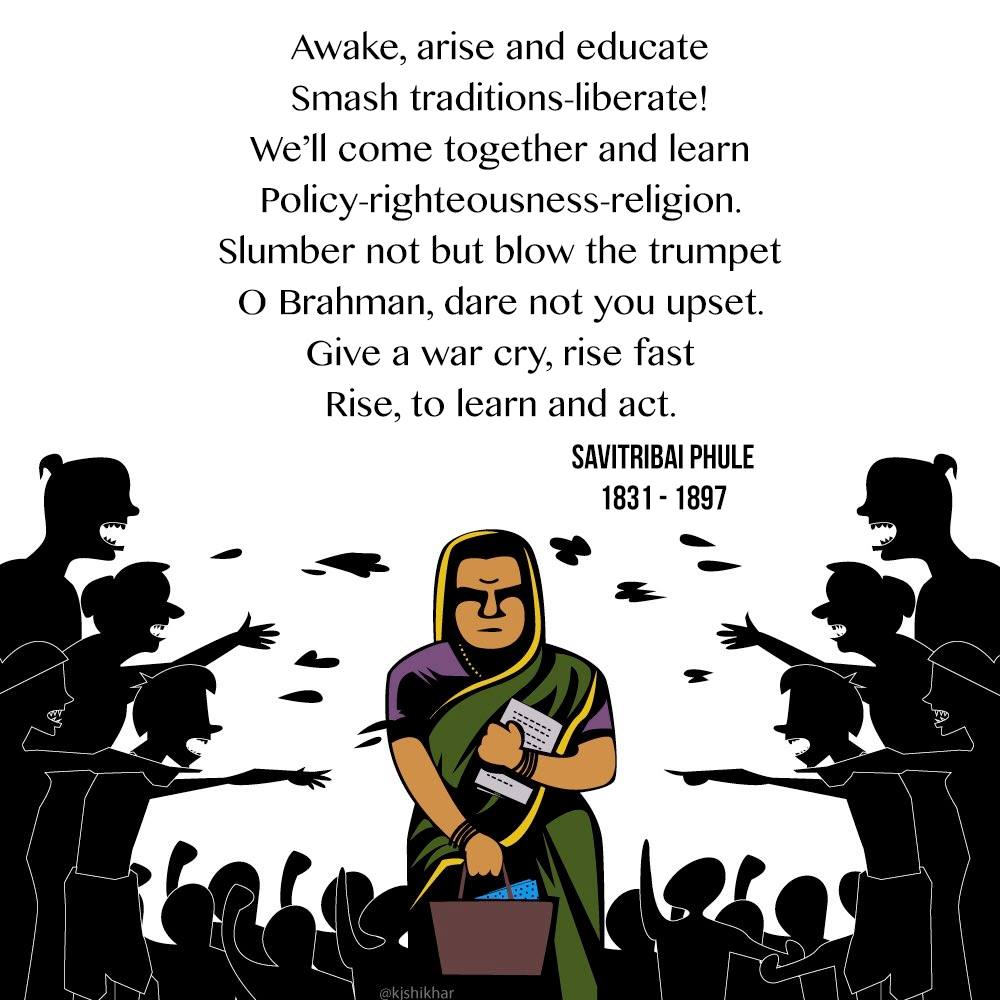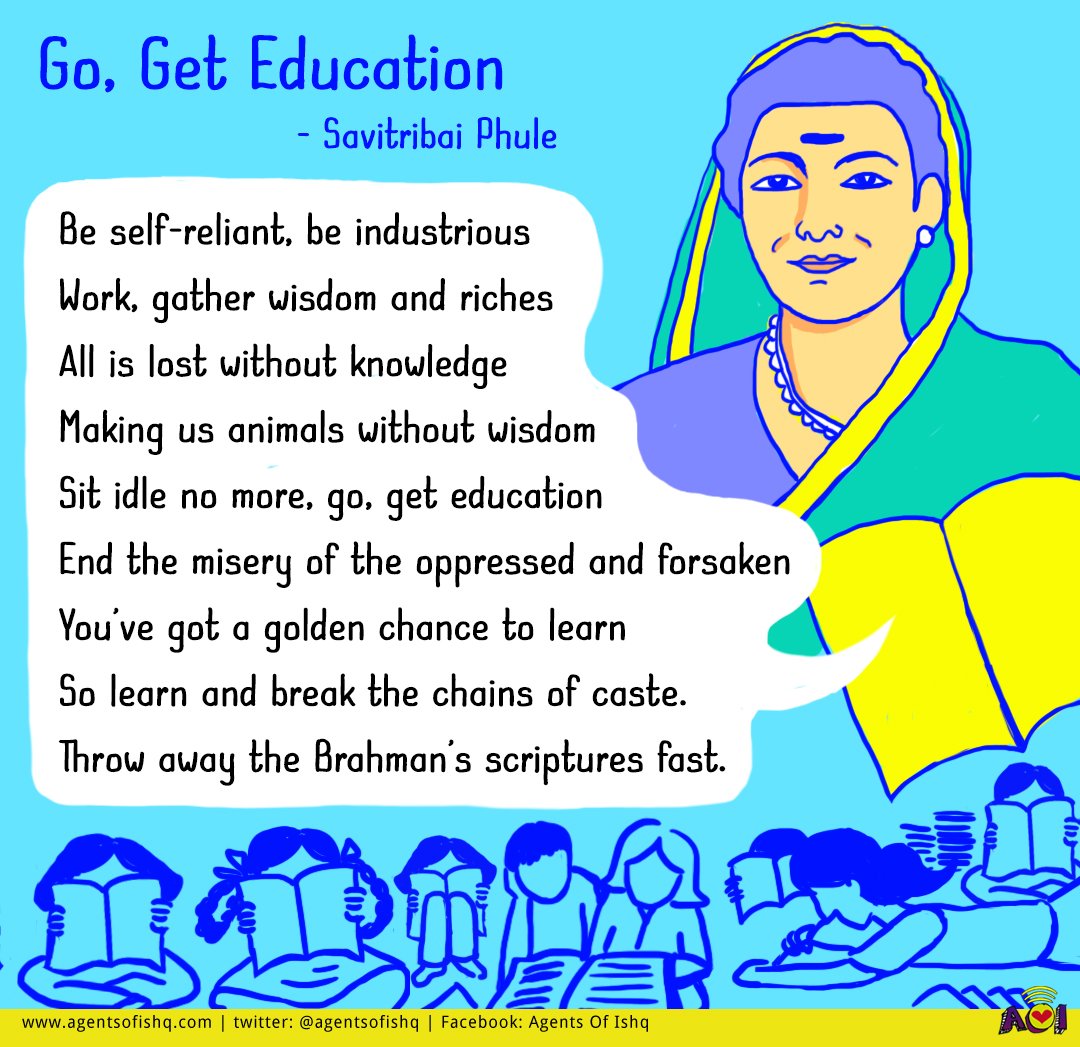Let us keep the lamp of revolution lit by Krantijyoti Savitribai alive!
By Swathi, HfHR Volunteer
While studying feminism in Modern India, my professor pointed to the entire class and said, “Nearly half this class wouldn’t have been here, if not for this women! All of us should be grateful for the efforts she took for us to be here, to be able to sit in a university and receive education, something we might just be taking for granted right now.” And most of us got goosebumps as she said so.
My professor was referring to Savitribai Phule,
“Modern India’s first woman teacher, a radical exponent of mass and female education, a champion of women’s liberation, a pioneer of engaged poetry, a courageous mass leader who took on the forces of caste and patriarchy certainly had her independent identity and contribution.”
As we celebrate her 191st birth anniversary today, let us look back at the life of this magnificent persona, who was way progressive of her times.
Birth and Marriage
Savitribai was born on January 3, 1831, in Naigaon village (Maharashtra) into a socially oppressed Mali community (traditionally gardeners). Like most girls of her time she was illiterate and was married off at an early age of merely 9-years to Jyotirao Phule who was also just 13 years-old then.
Jyotirao was a staunch believer of the power of education and the need for a just and equal society. He taught Savitribai initially, much against the wishes of the family members, and later enrolled her in a teachers’ training institute. These were the times when caste-oppressed men and all women were barred from education in Indian society.
Modern India’s first female teacher
After qualifying as a teacher she along with her husband and Sagunabai, Jyotiba’s mentor, started teaching girls in Mahar wada (dalit community) in Pune and later started the first girl’s school in Bhide Wada–a structure currently in a dilapidated condition. The school initially commenced with about 9 girls and gradually increased to about 25. The Phule couple in their lifetime went on to open more than 18 schools and 52 hostels. “The number of girl students in Jotirao’s (sic) school is ten times more than the number of boys studying in the government schools,” read an article published in The Poona Observer in 1852. For their significant contributions in the field of education, the Phule couple received accolades from the British.
What makes Savitribai unique is not just her being the first female teacher but also being the first few teachers who championed the cause of girls’ education and that of socially backward castes’ at a time when doing so was considered nearly blasphemous. Further, the Phules’ curriculum focused on subjects such as English, Science, Math and Social Sciences, instead of the conventional religious scriptures.
The story of a spare saree
The Phule couple swam against the tide, trying to narrow the inequalities within society, uniting various sections of the oppressed, whom they called stree-shudra-atishudra (women-lowcastes-outcastes/untouchables). This angered the privileged castes and conservatives–those who thought it was a sin to educate girls/women and oppressed castes. They spread rumors such as Jyotiba dying prematurely due to Savitribai’s work, their food turning into worms and educated women penning letters to unknown men. When this tittle-tattle had no effect on Savitribai, who continued her work undauntingly, they adopted other sordid means.
Everyday when she walked to the school to teach, they would hurl stones, rotten eggs and garbage on her, to which she would politely reply, “Your efforts inspire me to continue my work. May god bless you.” But slowly the taunts and curses started overpowering her will and she was on the brink of giving up. At this Jyotiba suggested that she carry a spare saree. So every day, she would change into her spare sari after reaching school and again change back to the original saree while coming back home. This is how she braved the brahmanical and patriarchal society nearly 200 years back–patiently, yet full of determination.
Pioneer of women’s rights and Intersectional feminism
As the opposition from the society grew, the Phule couple were thrown out of the house by their parents. It was Usman Sheikh, their friend who provided them shelter in such stressful times. Usman’s sister Fatima Begum who was already literate, now started working with Savitribai on education and went on to become India’s first Muslim woman teacher.
Savitribai set up the Mahila Seva Mandal in 1852, which worked for emancipation of women by raising their consciousness about their human rights, the dignity of life and other social issues. Prominent topics discussed in the society were child marriage, sati system and female foeticide. She also organized successful barbers' strikes against the prevailing practice of tonsuring of widows’ heads.
Once, a young Brahmin widow who worked as a cook in Jyotiba’s friend house was raped by a brahmin neighbour which resulted in her pregnancy. This led to her killing her newborn baby and being sentenced to life imprisonment. This shook the Phule couple and they decided to set up the ‘Balhatya Pratibandak Gruha’, a home for childcare and protection of pregnant widows and rape survivors. Pamphlets advertising the home provocatively read:
“Widows, come here and deliver your baby safely and secretly. It is up to your discretion whether you want to keep the baby in the center or take it with you. This orphanage will take care of the children [left behind].”
Later, a child born at this very center was adopted by the couple and named Yashwant.
Satyashodhak Samaj and Sarvajanik Satya Dharma
The Phule couple started the Satya Shodhak Samaj (truth-seekers’ society), a social reform society that was open to all irrespective of caste, class, gender, religion or any social stratification, with the sole objective of bringing social equity. Satya Shodhak Marriages were solemnized without priests, without dowry and with a pledge to promote education and equality whose procedures are detailed in Jyotiba’s book Sarvajanik Satya Dharma.
Even in today’s times when inter-faith marriages are termed as “Love Jihad” and inter-caste marriages comprise just 2 percent of marriages in India progressive Savitribai believed in them. Here’s an excerpt from her letter to Jyotiba narrating how she saved an inter-caste couple from violence:
“…One Ganesh, a Brahman, would go around villages, performing religious rites and telling people their fortunes. This was his bread and butter. Ganesh and a teenage girl named Sharja, who is from the Mahar (untouchable) community, fell in love. She was six months pregnant when people caught them and paraded them through the village, threatening to bump them off.
I came to know about their murderous plan. I rushed to the spot and scared them away, pointing out the grave consequences of killing the lovers under British law. They changed their mind after listening to me.
Sadubhau angrily said that the wily Brahman boy and the untouchable girl should leave the village. Both the victims agreed to this. My intervention saved the couple, who gratefully fell at my feet and started crying. Somehow I consoled and pacified them. Now I am sending both of them to you.”
Lighting the revolutionary fire
When Jyotiba died in 1890, and there was a discussion if her adopted son or other family members should light the pyre, she went forward and lit it herself. Cynthia Stephen, a Bengaluru-based independent writer, researcher and activist believes “That is why I feel she deserves the name, Kranti Jyoti."
She led the Satyashodhak Samaj from there on and became invested in it full-time.
One of India’s first few poetesses
Savitribai was a renowned poet too who mostly wrote about caste and patriarchy. Her poetry is a reflection of a revolutionary yet sensitive mind which was contagious. She published two poetic collections, Kavya Phule and Bhavan Kashi Subodh Ratnakar and also edited Jyotiba’s speeches into a volume and published it in 1856.
Bubonic Plague’s Frontline Warrior
In 1897 a deadly bubonic plague epidemic was ravaging Maharashtra. Savitribai opened a clinic in Hadapsar, Pune with the help of her son who was now a doctor. She fed nearly 2000 people everyday during the epidemic. One day she carried a physically infected child to the hospital and contracted the disease from him which caused her death on March 10, 1897.
Savitribai left behind a legacy of social reform, female empowerment and equitable justice which our generation more than any has the onus to carry forth. She will continue to remain an inspiration to women rights activists who strive to liberate our society from regressive thoughts and ideas that hinder the materialization of a just and egalitarian society.
Today on her birth anniversary, let us strive to keep the lamp of revolution lit by Krantijyoti Savitribai alive in our thoughts and actions!
Resources
A Forgotten Liberator, by Braj Ranjan Mani & Pamela Sardar
https://www.asiaville.in/article/savitribai-phule-jotirao-feminist-26484
https://www.livemint.com/Leisure/DmR1fQSnVD62p4D3eyq9mO/The-life-and-times-of-Savitribai-Phule.html



